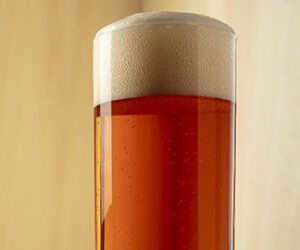Homebrewing During Prohibition
Mother’s in the kitchen Washing out the jugs; Sister’s in the pantry Bottling the suds; Father’s in the cellar Mixing up the hops; Johnny’s on the front porch Watching for the cops
–Poem by a New York state Rotary Club member during Prohibition
Prohibition accentuated the “home” in homebrewing.
Many American families recount and cherish tales of grandpa’s inept experimental attempts to brew beer in the kitchen and grandma’s gallant efforts to hide the results from Prohibition agents. Although most homebrewers practiced their hobbies with minimal adverse consequences, this homebrewing boom did have a casualty: the reputation of homebrewing.
In an era when intoxicating liquors were illegal, the ingredients to produce them were not. “For so long as the fruits of the orchard, the grain and roots of the field remain, the distiller and home-brewer have an inexhaustible supply of the raw material for producing alcohol. It is a matter of common notoriety that we are becoming a nation of adepts in the making of intoxicants,” wrote John Koren, author of Alcohol and Society, in his essay “Inherent Frailties of Prohibition.”
The Homebrew Market
While Prohibition formally ended the sale of intoxicating beverages from 1920 to 1933, it inspired an explosion in homebrewing. Beer consumption increased gradually during the 1920s, climbing to about 25 percent of its pre-Prohibition rate by 1930. This homebrewing revolution was sustained with the eager assistance of merchants who sold malt extracts for “baking.”
“Before Prohibition there waslittle or no malt extract on the market. Now there is an enormous amount of baking done, according to the amount of extracts being sold,” wrote A. W. McDaniel, a Prohibition agent. Eight years after Prohibition began, more than 500 malt and hop shops prospered in New York City. Another 100,000 stores sold malt syrup nationwide, including Atlantic and Pacific (A & P), Kroger, and Piggly-Wiggly grocery stores. Prior to Prohibition only 500 to 600 shops sold malt syrup nationwide. By 1928 25,000 shops, including Woolworth’s, were selling homebrewing equipment such as bottle cappers and tubing.
Sales of malt syrup boomed. In 1926 438 million pounds were produced and in 1927 450 million. An estimated 90 percent of this syrup was used to brew 6.5 billion pints of beer. Some homebrewers made beer from scratch, while others supplemented the potency of near beer, which was legal, with the help of malt syrups. Even with this use, between 1920 and 1928 production of near beer plummeted from 285 million gallons to about 100 million gallons.
In one year hop sales, excluding sales for near beer and export, exceeded 13 million pounds, the vast majority of which was presumably used to brew beer at home. By 1929 the Prohibition bureau, using sales figures for hops, malt, and other ingredients, estimated that Americans brewed 700 million gallons of beer at home.
Businesses thrived by selling equipment and other supplies to make liquor. In 1928 a writer for Collier’s magazine observed: “It looks very much as if the wet [pro-alcohol consumption] half of the population is busy making wet goods and the dry half is busy selling the ingredients and the machinery.” In the mid-1920s sales of homebrewing paraphernalia and ingredients amounted to roughly $136 million annually.
Legal Trade
Business was so good that as their influence and income grew, the malt syrup manufacturers and merchants formed their own national trade associations, the National Association of Malt Syrup Manufacturers (the producers) and the Interstate Food Products Association (the retailers and wholesalers). These associations promoted their products in trade journals entitled Sips and Malt Age.
Advertising and selling malt syrups without running afoul of the law was a tremendous challenge. Although not illegal per se, the possession and sale of brewing ingredients and equipment could not be advertised to indicate that their intended use was for brewing or beverage purposes. As a result of this law, the syrup industry had its product designated as food by the patent office and stressed this classification to its members. Some manufacturers followed the advice of the malt syrup manufacturers’ association and advertised their syrups with an emphasis on the virtues of the syrup for baking and other food-related uses. Manufacturers also omitted the words “hops” and “hop flavored” from their labels.
Some manufacturers did not always adhere to these recommendations. One advertisement was illustrated with a drunken camel leading four other equally besotted camels in a rendition of Sweet Adeline. In a thinly veiled attempt to keep fellow syrup manufacturers at bay, the advertisement also mentioned food uses for the syrup. Since the syrups were supposed to be used for baking hop-flavored muffins, they were named in such a way as to only intimate their intended use. Gesundheit, Nitecap, Bismarck, Double Dutch, Mixit, and Pilzenbaur malt syrups were all sold to the public.
Busted!
In the first 10 years of Prohibition, federal agents seized one billion gallons of malt liquor. The beer was customarily described as undrinkable, unsanitary, and filthy. Homebrewed beers were characterized as sludge-like with a mud-brown appearance, a sour and yeasty smell, and a taste like laundry soap. Some noted after effects could be equally disagreeable. Beers were described as “explosive” with a tendency to cause severe headaches and an inability to focus one’s eyes.
Hugh F. Fox, secretary of the US Brewers Association and a leading spokesman for the wets and the brewing industry, called homebrewed beer “troublesome and messy, and not very successful” and added that one could not produce “a light, palatable, and wholesome brew without the use of highly specialized and costly apparatus and facilities for sterilizing, filtering, and refrigeration.” He went on to describe the ales as a “poor imitation of old-fashioned stock ales, which contain at least twice as much alcohol as the lager beer of commerce.”
Although not always refreshing, homebrews were not nearly as dangerous as other alcoholic beverages concocted during the era. Drinking some homemade liquors had dreadful consequences including paralysis and death. Tens of thousands of people died from alcohol poisoning from beverages made from denatured alcohol intended for industrial use. This “liquor” contained traces of poisons such as sulfuric and hydrochloric acids and wood alcohol. According to the US Public Health Service, 11,700 people died from imbibing poisonous liquors in 1927. Embalming fluid, antifreeze, and rubbing alcohol were also used to make homemade liquors.
George S. Hobart, a former member of the New Jersey assembly, in arguing that beer sales should be limited to near beer, wrote: “I am told that a recent test has been discovered in Washington which can be used only when the moon is at the full. It is said that if a man sees only one moon he has been drinking less than one half of one percent [beer]; if he sees two moons he has been drinking more than one half of one percent; and if he sees no moon at all, he has been drinking wood alcohol!”
Under the National Prohibition Act, “any room, house, building, boat, vehicle, structure, or place where intoxicating liquor is manufactured, sold, kept or bartered…is declared to be a common nuisance.” The misdemeanor of homebrewing could result in a fine of up to $1,000 and/or imprisonment of up to one year. This law was rarely enforced because homebrewers mostly operated within the privacy of their homes, and it was difficult to invade private homes.
Law enforcement encountered a legal quandry in the attempted enforcement of anti-homebrewing laws and as a result did not often enforce them on private individuals. To search a private dwelling agents needed a search warrant. However, warrants could only be issued if there was evidence a residence was being used for the sale of liquor, not just production for home use.
A writer in the late 1920s noted that if a dry had his way and a homebrewer’s home was not respected as being private in the courts, “America would become almost at a stroke the world’s greatest homeless country, and instead the land of breweries, wineries, and distilleries.”
When homebrewers were brought into court, it often resulted in mild or no sanctions. A Nebraska attorney, Frank Bartos, was nearly disbarred as a result of his homebrewing. Agents caught Bartos with 700 quarts of homebrewed beer. Even though Bartos violated the law, an appeals court found that “the act was in private social life, and not professional character.” Homebrewing was deemed not to be an act of “moral turpitude” but rather a private act that did not reflect on Bartos’ fitness to practice law. One judge wrote, “The offense of Bartos was possibly the mildest that could be committed under the National Prohibition Act, were it not for the large quantity of beer so made.” Parenthetically, he went on to comment that “700 quarts of beer would indicate considerable capacity on the part of his family, or numerous guests with large capacities.”
A Beer By Any Other Name…
Since Prohibition outlawed the manufacture, sale, and transportation of intoxicating beverages including beer, the definition of how much alcohol is necessary to make a drink intoxicating and what constitutes “beer” was a matter of constant debate. Common defenses to homebrewing included the claim that homebrew was not an “intoxicating beverage” under the National Prohibition Act and that “homebrew” is not by definition the same as “beer.” Although “beer” was recognized under the law as being illegal, “homebrew” was not.
In arguing for the legalization of a real beer containing 3 percent alcohol, Sen. Walter E. Edge of New Jersey wrote that the word beer suggests “the old days of reeking barrooms and saloons.” He facetiously suggested that if the three percent beverage were called “sunshine” or “golden dew,” no one would complain about its production. Senator Edge reasoned “that it is the word ‘beer’ which is antagonized rather the contents or the effects thereof.”
Prohibition agents were not par-ticularly distressed by homebrewing when other more potent and portable liquors were available. In publicizing a $25,000 prize for the best plan for repealing the 18th amendment, which stresses temperance rather than outright prohibition, publisher William Randolph Hearst wrote that it is “easier for the law-defying element to deal illicitly in hard liquors than in the milder and bulkier form of alcoholic drinkables.” This was especially true because under Prohibition “a man who wants a mild drink is compelled to take a strong one; and a man who wants a good drink is compelled to take a bad one.”
The homebrewing boom was not sustained after Prohibition. The often muddy, unpalatable, and amateurish beers of the homebrewer lost favor to the pale, lightly hopped beers of the professional brewers. Brewers geared up for production as soon as Prohibition ended, and homebrewing did not become legal until 1979. Shortly after midnight on the day Prohibition officially ended, a brewer from St. Louis delivered two cases of beer to the White House with the salutation, “Here’s to you — President Roosevelt.”



